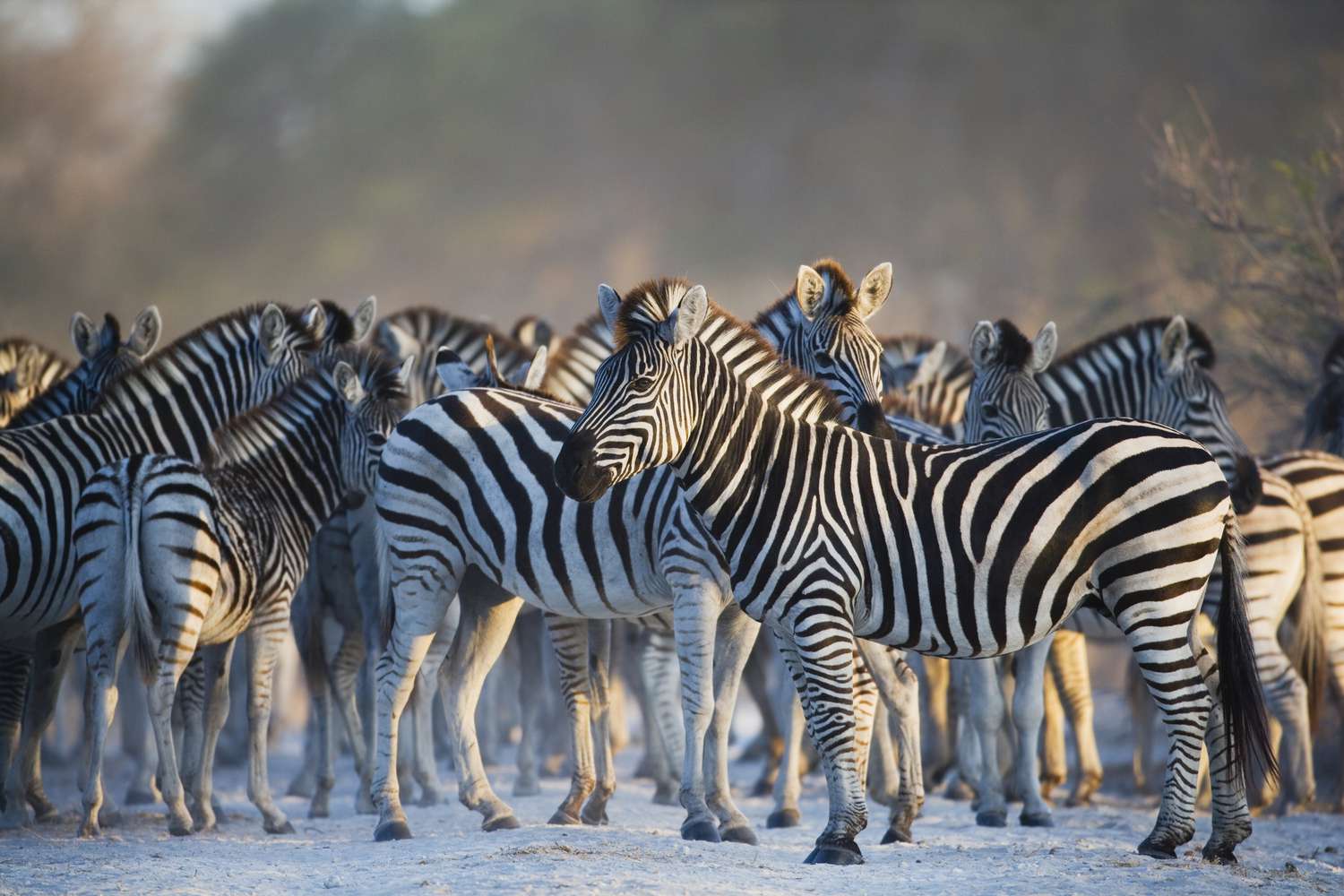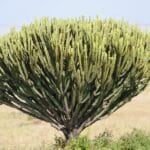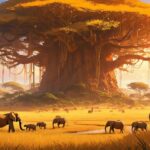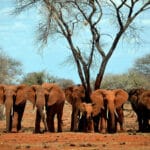Are you captivated by the incredible creatures that roam the African wilderness? From the majestic elephants to the stealthy leopards, Africa is a continent where nature puts on an unforgettable show. In this article, we’ll uncover some intriguing trivia about African wildlife that will leave you utterly astounded. We’ll delve into the legendary Big Five, the cooperative hunting strategies of African wild dogs, and surprising facts about the giants of the savanna – the elephants. Let’s embark on a journey into the wild heart of Africa and discover its captivating secrets!
Fascinating African Wildlife Trivia
Africa consistently steals the show in the realm of online animal videos, and for good reason! This continent pulsates with an astonishing array of creatures. Prepare to be amazed as we unveil some seriously cool trivia about these wild animals.
Leaving Everyone in the Dust: The Cheetah’s Need for Speed
Imagine a furry projectile rocketing across the savanna! The cheetah, renowned for its sleek physique and spotted coat, isn’t just a fashion icon – it’s the planet’s fastest land animal. We’re talking speeds that could rival a car on the highway – up to an astonishing 70 miles per hour! This incredible burst of speed is their secret weapon for snatching meals in the vast African plains. Witnessing a cheetah in full flight is a breathtaking spectacle, showcasing the raw power of nature.
Elephants: Gentle Giants with Giant Appetites
Elephants, those majestic behemoths with their deep rumbles and wise eyes, are impossible to ignore. But did you know their appetites are just as colossal as their presence? Picture this: an elephant can devour a staggering 250 pounds of plants every single day. That’s like consuming the contents of an entire salad bar… ten times over! It takes a lot of fuel to keep these incredible creatures going.
Teamwork Makes the Dream Work: African Wild Dogs on the Hunt
While many animals prefer a solitary existence, African wild dogs are all about collaboration. These vibrantly painted canines, with their unique markings and expressive ears, are the ultimate team players. They join forces to bring down prey far larger than themselves, employing clever tactics and intricate communication to outmaneuver their target. It’s a powerful reminder that sometimes, working together is the key to success, even in the unforgiving wilderness.
A Shadow Over Paradise: The Challenges Facing African Wildlife
Sadly, this incredible wildlife faces daunting challenges. Human activities, such as habitat encroachment, leave these animals with less space to roam freely. Poaching, fueled by the insatiable demand of the illegal wildlife trade, casts a dark shadow over these magnificent creatures. It’s a stark reminder of our responsibility to protect these animals and secure their future. Protecting them isn’t just about preserving biodiversity; it’s about safeguarding a world brimming with wonder and endless fascination.
What is a fun fact about the African animal?
We’ve already uncovered some amazing facts, but hold on tight because there’s a whole universe of fascinating trivia about African animals just waiting to be explored!
Ever heard of an animal architect? Well, African elephants are like the master builders of the savanna! These gentle giants, besides being the largest land animals on Earth, are surprisingly adept at reshaping their environment. They’re like ecosystem engineers, utilizing their massive size and strength to dig water holes when thirst strikes. These watering holes then become lifelines for other animals struggling to survive during dry spells. And their impact doesn’t stop there. Elephants clear paths and topple trees, which might seem destructive at first glance. However, these actions create open spaces where new plants can flourish and various species can thrive. Talk about a positive impact!
Now, let’s talk about lions. Think teamwork makes the dream work? Lions take it to a whole new level! They live in complex social structures called prides, which are like large, extended families. Lions have an incredibly sophisticated hunting strategy. Instead of hunting solo, they work together, using each lion’s strengths to their advantage. This collaborative approach allows them to take down prey far larger than any individual lion could handle. Plus, belonging to a pride provides enhanced protection for their territory and vulnerable cubs. It’s a testament to the remarkable power of cooperation in the animal kingdom.
But it’s not all sunshine and rainbows in the animal kingdom. Let’s talk about pangolins, those incredibly unique creatures that sadly hold a heartbreaking record – they are the most heavily trafficked mammals in the world. What makes them so desirable, you ask? Their scales. Some people believe these scales possess medicinal properties, which has fueled a devastating demand in the illegal wildlife trade. While considerable effort is being made to protect these amazing animals, it’s an uphill battle that demands global awareness and decisive action.
Want to learn more? There is a treasure trove of fascinating facts about African animals just waiting to be unearthed. Organizations like the African Wildlife Foundation are incredible resources. They offer a wealth of information on conservation initiatives and the remarkable wildlife they are diligently working to protect.
What is the iconic animal of Africa?
Choosing just one iconic animal to represent the entirety of Africa’s wildlife is no easy task. It’s like selecting a favorite star from a sky teeming with celestial wonders! Africa overflows with incredible creatures, each weaving its own unique narrative into the tapestry of life on the continent.
The Famous Five (and Then Some!)
You’ve likely encountered the “Big Five” – the lion, elephant, leopard, rhino, and buffalo. These magnificent animals are like the A-list celebrities of the animal kingdom, and for good reason! They are powerful, majestic, and embody the wild spirit of Africa. But let’s not forget the other extraordinary creatures that call this continent home.
Imagine giraffes gracefully stretching their necks to nibble on leaves high in the treetops, their patterned coats blending seamlessly into the dappled sunlight. Or picture a cheetah, a blur of spotted muscle, relentlessly chasing down its prey across the vast expanse of the savanna. And let’s not forget the hyenas, those often misunderstood but absolutely crucial players in maintaining the delicate balance of the ecosystem.
Choosing just one iconic animal to represent all of Africa is like attempting to encapsulate the essence of an entire continent in a single word. It’s simply not possible! Every animal plays a vital role in the intricate web of life. There’s an overwhelming abundance of variety and wonder.
So, Where Do We Go From Here?
While singling out just one iconic animal for Africa might be an impossible feat (and perhaps even a bit unfair!), there’s no denying the powerful impact of the “Big Five” on our collective imagination. They’ve become symbols of conservation efforts and powerful reminders of the raw beauty and untamed power of the natural world.
But the next time you find yourself lost in a daydream about Africa, try to expand your horizons beyond the “stars” of the show. Think about the entire cast – the big and the small, the hunters and the hunted, the familiar faces, and the hidden gems. Because when it comes to Africa, every single creature plays an essential role in making it the awe-inspiring, unforgettable continent that it is.
What is the Big Five of the African wildlife?
Let’s turn our attention to the true celebrities of the African savanna – the legendary Big Five! This isn’t some exclusive club. It’s a title bestowed upon five of the most iconic animals you could ever hope to encounter on a safari: the lion, the leopard, the elephant, the buffalo, and the rhinoceros. These magnificent creatures have captivated adventurers and explorers for centuries, embodying the raw power and breathtaking beauty of African wildlife.
You’ve probably seen countless photographs, but let me tell you, nothing compares to locking eyes with a lion in the flesh. With their majestic manes and piercing gazes, they truly live up to their title as the “king of beasts.” They are surprisingly social animals and often hunt cooperatively, which makes observing them in action even more impressive.
Then we have the leopard, a master of stealth and camouflage. These elusive felines are like the ninjas of the savanna, silently stalking their prey with incredible agility and precision. Consider yourself lucky if you catch even a fleeting glimpse of one – they are masters of blending into their surroundings!
Of course, no conversation about African wildlife would be complete without mentioning the elephant. Let’s face it, they’re rather difficult to miss! These gentle giants are the largest land animals on Earth, and they possess a surprising level of intelligence and social complexity. Seriously, their memory and the profound bonds they form within their family units are awe-inspiring.
Next up, we have the buffalo. Now, you might mistake them for oversized cows at first glance, but don’t be fooled. These bovids sport massive horns and possess an incredibly stubborn streak. And when they roam the savanna in their vast herds, they are a force to be reckoned with.
And last, but certainly not least, we have the rhinoceros. These ancient-looking creatures have been around since the age of dinosaurs, and their thick hides and distinctive horns make them an unforgettable sight. Tragically, rhinos are facing grave threats due to poaching, making conservation efforts absolutely crucial to ensuring their survival.
Here’s the thing about the Big Five:
- The term “Big Five” wasn’t coined because these animals are the largest. Rather, they were deemed the most challenging and dangerous animals to hunt on foot in the early days of big game hunting. Thankfully, in the modern era, safaris are all about respect, appreciation, and observation, not hunting.
- While each of these animals is incredible in its own right, witnessing them interacting with one another and with their environment is what truly makes the African savanna such a special place. It’s a delicate balance, and researchers are constantly uncovering new insights into the complex relationships that exist between these animals and their ecosystem.
So, there you have it! The Big Five – five incredible animals, each with its own captivating story to tell, all essential threads in the intricate tapestry of the African wilderness.
What is African wildlife called?
We’ve already established that Africa teems with an incredible array of creatures, but what do we call all of these amazing animals collectively? Well, it’s quite simple – we refer to them as African wildlife. This all-encompassing term encompasses the vast and diverse range of animal species that call this incredible continent home. From the tiniest insects to the largest mammals, each creature plays a vital role in the intricate and interconnected web of African ecosystems.
Of course, we can’t forget about Africa’s superstars, the “Big Five” – the lion, elephant, leopard, buffalo, and rhinoceros. These majestic animals have ignited the imaginations of explorers and wildlife enthusiasts for centuries and are instantly recognizable symbols of Africa’s untamed beauty. But Africa’s wildlife is so much more than just these iconic creatures. The continent teems with lesser-known animals that are just as captivating and ecologically important.
For instance, did you know that Africa is home to over 1,100 different types of mammals? That’s an astonishing number! From the minuscule pygmy shrew, weighing in at a mere couple of grams, to the mighty African bush elephant, the largest land animal on the planet, the diversity is truly mind-boggling. And let’s not forget about the birds! Over 2,600 species of birds grace the African skies, from the vibrantly colored sunbirds flitting among blossoms to the majestic eagles soaring effortlessly above. And have you ever witnessed a flightless ostrich sprinting across the savanna? Talk about an unforgettable sight!
But Africa’s wildlife isn’t limited to mammals and birds. The continent also teems with reptiles and amphibians, each uniquely adapted to thrive in Africa’s diverse habitats. The Nile crocodile, the largest reptile in Africa, is a truly awe-inspiring sight, while the tiny, leaf-mimicking frog showcases the incredible camouflage skills present in the animal kingdom. These creatures, along with countless others, contribute to the rich tapestry of life that makes Africa so utterly unique.
It’s essential to remember that African wildlife isn’t just a collection of individual species; it’s a complex interconnected web of life. From dung beetles diligently recycling nutrients to elephants literally shaping the landscape, every single organism plays a crucial role in maintaining the delicate balance of their ecosystem. Understanding these connections and the potential impact of our actions on these delicate balances is paramount to ensuring the survival of these incredible animals for generations to come.
While we’ve learned a great deal about African wildlife, ongoing research continues to reveal new discoveries and deepen our understanding of these complex ecosystems.
What is an unusual fact about Africa?
Africa is already bursting with fascinating wildlife and breathtaking landscapes, but did you know it also harbors a treasure trove of quirky secrets? Let’s delve into some of the unusual facts that make Africa truly one-of-a-kind.
1. The Giants Among Us
We all know elephants are massive, but the African elephant takes the prize as the largest land animal on Earth. Imagine a male elephant weighing as much as 14,000 pounds! That’s equivalent to six cars piled up! These gentle giants are keystone species, playing a crucial role in their environment. They topple trees, create pathways, and even dig water holes that sustain other animals.
2. Need for Speed: Cheetah Edition
Picture this: you’re cruising down the road, and suddenly, a cheetah zooms past you at a mind-blowing 70 miles per hour. That’s right! These incredible cats are the fastest land animals on the planet, built for speed with their streamlined bodies and powerful legs. The African savanna is their racetrack, and they always take home the gold.
3. The Scaly Mystery of the Pangolin
Ever heard of a pangolin? These shy creatures resemble walking pinecones! Found in Africa and Asia, they’re covered in tough, overlapping scales that provide protection from predators. They’re nocturnal, venturing out under the cover of darkness to feast on their favorite snacks – ants and termites. Talk about a specialized diet!
4. The Underwater Acrobatics of Hippo Births
You might envision hippos spending their days lounging in the water, but their birthing process is surprisingly athletic! Female hippos give birth underwater, and their newborns instinctively know to swim to the surface for their first breath of air. It’s a delicate and remarkable dance of nature that never fails to amaze researchers.
5. A Land of Diversity and Wonder
Africa is the second largest continent on Earth, and it’s not just about the animals! It’s incredibly diverse, encompassing everything from lush rainforests to sprawling deserts. Scientists are continuously making new discoveries about this incredible continent, making it an endlessly fascinating place to learn about.
Keep Exploring!
These are just a few of the many unusual facts that make Africa so unique. There’s always something new to uncover, from its diverse ecosystems to the incredible adaptations of its wildlife. So, keep exploring and keep learning!
What are 5 Interesting Facts About African Wild Dogs?
We’ve already touched on how cool African wild dogs are, and trust me, the list goes on! These canines are full of surprises. Let’s delve into a few more fascinating facts about these amazing creatures:
- They’re Like the Chatty Cathys of the Savanna. Have you ever listened to a group of friends chattering away? That’s kind of what it’s like with African wild dogs! They live in large packs – sometimes up to 20 strong – and they are always talking to each other. It’s not just idle chatter, though. They have a complex system of hoots, whistles, and other sounds that help them keep track of each other and coordinate their next meal.
- Teamwork Makes the Dream Work (Especially When Hunting). These dogs are not messing around when it comes to dinnertime. Imagine a pack of elite athletes coordinating their every move to capture prey many times their size. That’s African wild dogs in a nutshell! They’re renowned for their incredible teamwork during hunts, bringing down zebras and wildebeest like a well-oiled machine.
- Sadly, Their Numbers are Dwindling. This is where things take a somber turn. African wild dogs are classified as an endangered species. Habitat loss, human-wildlife conflict, and disease are just a few of the factors contributing to their decline. Experts believe there are only around 3,000-5,000 left in the wild, making conservation efforts more critical than ever.
- They’ve Got a “Call Sign” That’s Music to Their Ears. You know how some birds have really distinctive calls? Well, African wild dogs have something similar. They make this unusual “hooting” sound that’s unlike any other animal’s vocalization. Scientists believe it’s a way for them to communicate over long distances, which is incredibly useful when you’re traversing the vast African landscape.
- They’re Like the Guardians of Their Ecosystem. African wild dogs aren’t just cool-looking; they play a vital role in maintaining a healthy and balanced ecosystem. As highly skilled hunters, they help regulate populations of other animals, which prevents overgrazing and keeps the entire ecosystem in check. Scientists classify them as a “keystone species” – essentially, they’re a big deal in the circle of life.
What is special about animals in Africa?
We’ve already established that Africa’s wildlife is incredibly diverse, but let’s explore what makes these creatures so captivating. It’s not just the sheer variety; it’s how each animal has carved its niche, developing remarkable skills and behaviors to thrive in Africa’s diverse landscapes.
Think about size, for instance. Africa is home to some of the planet’s most massive land animals! Elephants, rhinos, giraffes – these giants have evolved into powerhouses, built to withstand the challenges of their environment. Their size alone is a testament to the powerful forces that have shaped their evolution.
But it’s not just about brute strength. Africa is also a land of astonishing speed and agility. The cheetah, the undisputed champion of land speed, can reach a mind-blowing 70 miles per hour in a matter of seconds. And then you have lions and leopards – masters of stealth and precision, perfectly adapted for hunting with a captivating blend of power and grace.
And speaking of adaptations, African animals possess an array of truly unique tricks. Consider meerkats, for example. They’re like the sentinels of the savanna, standing tall on their hind legs, utilizing their incredible eyesight, always vigilant for danger. Or chameleons, seamlessly blending into their surroundings by changing color – talk about camouflage! And let’s not forget the pangolin, encased in tough scales that transform it into a walking fortress.
But survival isn’t always about individual prowess. Many African animals are incredibly social, living in complex groups where cooperation reigns supreme. Elephants, led by wise and experienced matriarchs, form unbreakable bonds and work together to raise their young and navigate their territory. Lions, on the other hand, form prides, where teamwork is crucial for successful hunts and defending their domain.
The significance of African animals extends far beyond their aesthetic appeal. They play a vital role in maintaining healthy and balanced ecosystems. Herbivores such as zebras and wildebeest, constantly migrating and grazing on grasses, actually help prevent wildfires and ensure the health of the grasslands. Predators, such as lions and leopards, regulate herbivore populations, preventing overgrazing and maintaining the delicate balance of the entire ecosystem.
There’s still so much we’re learning about these incredible creatures. Scientists are constantly unearthing new discoveries about their behavior, adaptations, and intricate relationships with their environment. It’s a potent reminder that the natural world is full of wonder, and the more we learn, the more we realize how much more there is still to discover.
What is a fun fact about an animal?
Let’s delve into the world of fascinating African animals! We’re going beyond the well-known lions and zebras (although they are undeniably cool!) to explore some creatures you might not be as familiar with.
For instance, did you know those massive African elephants, the ones that can tip the scales at the weight of a school bus (we’re talking 14,000 pounds!), are actually the largest land animals on Earth? That’s a whole lot of elephant!
And speaking of speed, forget sports cars! Cheetahs are where it’s at. They can hit an astounding 70 miles per hour when pursuing prey. Imagine trying to outrun that!
But if you think speed is impressive, how about being a climbing champion? Leopards are like the stealthy acrobats of the savanna, spending a good portion of their day lounging in trees. Talk about a room with a view!
Now, you might assume hippos are natural-born swimmers, right? Well, it turns out they’re not particularly strong swimmers. They prefer to hang out in the water to stay cool and avoid becoming someone’s lunch, but they mostly just relax on the bottom or walk around.
Sadly, not all animals have it so easy. Pangolins, those adorable creatures that look like they’re wearing armor, are actually the most heavily trafficked mammals in the world. This is because some people mistakenly believe their scales possess medicinal properties, even though there’s no scientific evidence to support this claim. We must protect these amazing and vulnerable creatures.
Speaking of important jobs, let’s give a big shout-out to the dung beetles! They might not be the most glamorous creatures, but they play a vital role in the environment by breaking down animal waste and helping to disperse seeds. They’re like tiny, unsung heroes of the savanna.
And if you thought teamwork was exclusive to humans, think again! African wild dogs live in packs that can reach up to 40 members, and they work together to hunt and raise their young. Talk about family goals!
Then there are meerkats, those adorable little mammals that always seem to be on high alert. They engage in an amazing behavior called “sentry behavior.” One meerkat stands guard, keeping a watchful eye out for danger, while the others forage for food. It’s like having their own built-in security system!
And hold on to your hats because African grey parrots are basically the geniuses of the bird world. Not only are they capable of mimicking human speech, but they can also figure out how to solve complex problems. Some scientists believe they possess the intelligence of a human toddler.
Of course, we can’t forget about the Nile crocodile, one of the largest and – let’s be honest – most intimidating reptiles in Africa. They play a vital role in their ecosystem, even if they do send shivers down our spines from time to time.
The more we learn about African wildlife, the more we realize how much we still don’t know! Scientists are constantly making new discoveries, and it’s thrilling to ponder what other secrets these amazing animals might be hiding.
What are 5 Interesting Facts About African Elephants?
We’ve already explored how impressive African elephants are, but trust me, there’s a whole lot more to learn about these gentle giants. Let’s uncover some fascinating facts that make them truly remarkable.
- Longest Mammal Pregnancy: Did you know that African elephants experience the longest pregnancy of any mammal? We’re talking about an incredible 22 months! That’s almost two years. Scientists believe this extended pregnancy is necessary for elephants to grow to their incredible size and develop their complex social structures.
- Heavier Than a School Bus: Speaking of size, a male African elephant can weigh up to 13,000 pounds – that’s heavier than a school bus! Their size is a testament to their evolutionary adaptation to the African savanna.
- The Mighty Trunk: Now, let’s talk about those incredible trunks. An elephant’s trunk isn’t just some big nose; it’s a marvel of nature! It contains over 40,000 muscles, which gives it amazing dexterity and sensory perception. They use their trunks for everything from grasping tiny objects to communicating with low rumbles that can travel for miles. They can even suck up gallons of water with those amazing trunks.
- Memory Masters: But their physical attributes aren’t the only impressive thing about them. African elephants are incredibly intelligent creatures with remarkable memories. They can remember water sources they haven’t seen in years and recognize other elephants they’ve encountered even after long separations.
- Social Complexity: And their social lives are no less fascinating. They form strong family bonds and work together to protect their young, exhibiting remarkable cooperation and care.
Beyond being fascinating creatures, African elephants are essential to the health of their ecosystems. Think of them as natural gardeners. As they move across the savanna, they clear out vegetation, which helps to maintain a balance of plant life. They also dig waterholes, which not only quench their thirst but also provide a vital water source for other animals, especially during the dry season. And let’s not forget their role as seed dispersers! As they consume fruits and plants, they spread seeds across long distances, helping plants to thrive in different areas.
There’s still so much we are discovering about African elephants. Ongoing research continues to unravel the complexities of their behavior, communication, and ecological impact. One thing’s for sure, protecting these gentle giants is crucial. By supporting conservation efforts, we can help ensure that these magnificent creatures continue to roam the African landscape for generations to come.
What are 7 facts about Africa?
Let’s dive into some incredible facts about Africa that might just surprise you:
- Africa: Home to the Heavyweight Champion of the World! Remember those massive elephants we talked about earlier? Those giants are African elephants, and they hold the title of Earth’s largest land animals. We’re talking up to 13,000 pounds – that’s heavier than a school bus! And as if that weren’t impressive enough, they can reach over 13 feet tall at the shoulder.
- Lions: The Ultimate Team Players. While most big cats prefer to go solo, African lions are all about teamwork. They form these close-knit groups called “prides,” which can consist of up to 30 lions. And just like a well-oiled machine, they work together to hunt, raise their cubs, and defend their territory. Talk about family goals!
- The Elusive Leopard: Master of Stealth. Imagine this: dense forests and wide-open savannas. Now, try to spot an African leopard. Not easy, right? These incredible creatures are practically invisible, thanks to their incredible camouflage. They’re masters of stealth, adapting perfectly to their surroundings.
- The African Buffalo: Don’t Be Fooled by the Grazing. Sure, they might resemble giant cows, but African buffalos are a force to be reckoned with. These herbivores can grow up to 2,000 pounds – that’s as heavy as a small car! And those horns? Let’s just say you don’t want to be on the receiving end of a headbutt. They’re sharp and powerful, capable of inflicting some serious damage.
- The African Grey Parrot: A Bird Brain with a Talent for Language. Ever wished your pet could talk back? Well, African Grey Parrots take that to a whole new level! They’re known for their remarkable intelligence, possessing the uncanny ability to mimic human speech and even learn complex tricks. Some experts suggest they might even understand what they’re saying! Now, that’s food for thought!
- The African Wild Dog: A Pack of Underdogs Fighting for Survival. Sadly, these highly social animals face a challenging future. African wild dogs are one of the most endangered carnivores on the continent. Living in packs of up to 40 individuals, they rely on teamwork and cooperation to bring down prey. Conservation efforts are essential to ensure these remarkable animals have a future.
- Africa: The Elephant Kingdom. You know those gentle giants we discussed earlier? Well, Africa is their kingdom! It boasts the largest population of elephants globally, with an estimated 415,000 individuals. These incredible creatures play a crucial role in their ecosystem. Think of them as nature’s gardeners, dispersing seeds and even creating watering holes.
Keep Exploring!
This is just a glimpse into the incredible world of Africa. There’s so much more to discover about this fascinating continent and its wildlife. Prepare to be amazed by 10 amazing facts about Africa that will broaden your horizons! Uncover lesser-known African cultural traditions that offer a glimpse into the continent’s rich heritage and traditions.
- Mastering Leader in Spanish: The Complete Guide - April 19, 2025
- Uncovering Surprising Parallels: England Size Compared to US States - April 19, 2025
- Old Mexico Map: Border Shifts 1821-1857 - April 19, 2025
















